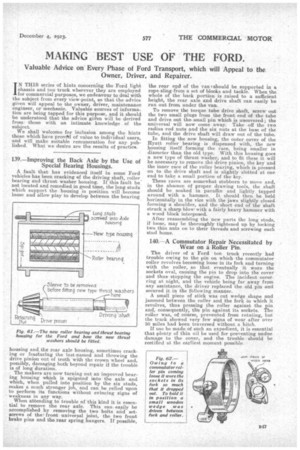MAKING BEST USE OF THE FORD.
Page 31

If you've noticed an error in this article please click here to report it so we can fix it.
Valuable Advice on Every Phase of Ford Transport, which will Appeal to the Owner, Driver, and Repairer.
IN THIS series of hints concerning the Ford light chassis and ton truck wherever they are employed for commercial purposes, we endeavour to deal with the subject from every view-point, so that the advice given will appeal to the owner, driver, maintenance 'engineer, or mechanic. Valuable sources of information are being tapped for this purpose, and it should be understood that the advice given will be derived from those with an intimate knowledge of the subject.
We shall welcome for inclusion among the hints those which have proved of value to individual users, and will make suitable remuneration for any published. What we desire are the results of practice.
139.—Improving • the Back Axle by the Use of Special Bearing Housings.
A fault that has evidenced itself in some Ford vehicles has been cracking of the driving shaft, roller, bearing and thrust washer housing. If this fault be not located and remedied in good time, the long studs which support the housing in position will become loose and allow play to develop between the bearing_ housing and, the rear axle housing, sometimes cracking or fracturing the last-named and throwing the drive pinion out of truth with the crown wheel and, possibly, damaging both beyond repair if the trouble is of long duration.
The makers are now turning out an improved bear. ing housing which is spigoted into the axle and which, when pulled into position by the six studs, makes a much stronger job, and can be relied upon to perform its functions without evincing signs of weakness in any way. When attending to trouble of this kind it is essential to remove the rear axle. This can easily be accomplished by removing the two bolts and setscrews of the front universal joint, the two front brake pins and the rear spring hangers. If possible, the rear end of the van t should be supported in a rope.sling.from a set of Mocks and tackle. When the whole of the back portion is raised to a sufficient height, the rear axle and drive shaft can easily be run out from under the van.
TO remove the torque tube drive shaft, screw out the two small plugs from the front end of the tube and drive out the small pin which is uncovered; the universal will now come away. Take off the two radius rod nuts and the six nuts at the base of the tube, and the drive shaft will draw out of the tube.
In fitting the new housing, the outer cover of the Hyatt roller bearing is dispensed with, the new housing itself forming the race, being smaller in diameter than the old type. With this housing goes a new type of thrust washer, and to 'fit these it. will be necessary to remove the drive pinion, the key and the inner race of the roller bearing, which is pressed on to the drive shaft and is slightly slotted at one end to take a small portion of the key.
These races are somewhat stubborn to move and, in the absence of proper drawing tools, the shaft should be soaked in paraffin and lightly tapped around with a hammer. It should then be held horizontally in the vice with the jaws slightly closed forming a shoulder, and the short end of the shaft struck a sharp blow with a fairly heavy hammer with a wood block interposed. • After reassembling the new parts the long studs, if loose, may be thoroughly tightened up by locking two thin nuts on to their threads and screwing each stud home.
140.---A Commutator Repair Necessitated by Wear on a Roller Pin.
The driver of a Ford ton truck recently had trouble owing to the pin on which the commutator roller revolves becoming loose in its fork and turning with the roller, so that eventually it wore the sockets oval, causing the pin to drop into the cover and thus stopping the engine. The incident occurring at night, and the vehicle being far away from any assistance, the driver replaced the old pin and secured it in the following manner. A small piece of stick was cut wedge shape and jammed between the roller and the fork M which it revolves, thus pressing the roller against the pin and, consequently, the pin against its sockets. The roller was, of course, prevented from rotating, but the track showed very few signs of wear after over 30 miles had been traversed without a hitch.
If use be made of such an expedient, it is essential that plenty of thin oil be used for preventing undue damage to the cover, and the trouble should be rectified at the earliest moment possible


































